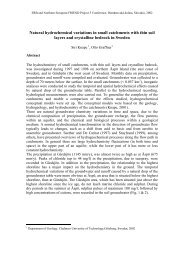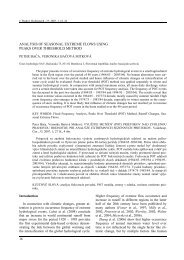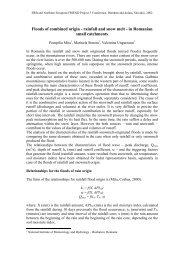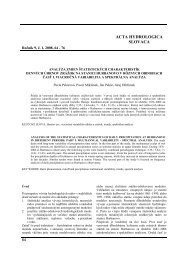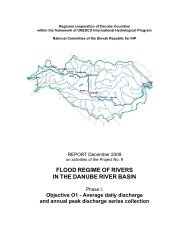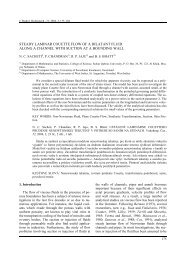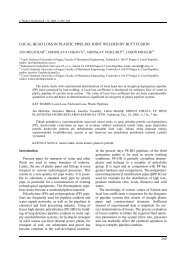TIME SERIES ANALYSIS OF HYDROLOGIC DATA FOR WATER ...
TIME SERIES ANALYSIS OF HYDROLOGIC DATA FOR WATER ...
TIME SERIES ANALYSIS OF HYDROLOGIC DATA FOR WATER ...
Create successful ePaper yourself
Turn your PDF publications into a flip-book with our unique Google optimized e-Paper software.
Time series analysis of hydrologic data for water resources planning and management: a reviewtiveness depends on the pre-assigned significancelevel, magnitude of trend, sample size, and theamount of variation within a time series. Thus, thebigger the absolute magnitude of trend or larger thesample size, the more powerful are the tests; but asthe amount of variation in a time series increases,the power of the tests decreases. When a trend ispresent, the power is also dependent on the distributiontype and skewness of the time series. It wasalso found that these two tests have practicallysimilar power in detecting a trend.Clarke (2002) described a model in which theGumbel distribution has a (possibly) time-variantmean. The time-trend in mean value was determinedby a single parameter β estimated by MaximumLikelihood (ML). The large-sample varianceof the ML estimate was compared with the varianceof the trend calculated by linear regression; thelatter was found to be 64% greater. The simulatedsamples from a standard Gumbel distribution weregiven superimposed linear trends of different magnitudes,and the efficacy of three trend-testingmethods viz., Maximum Likelihood, Linear Regression,and the nonparametric Mann-Kendall Testwas compared. The ML Test was found alwaysmore powerful than the Linear Regression orMann-Kendall Test regardless of the value (positive)of the trend β; the MK Test was found leastpowerful for all the values of β.Ducré-Robitaille et al. (2003) evaluated eighthomogenization techniques for the detection ofdiscontinuities in the temperature series using simulateddatasets reproducing a vast range of possiblesituations. The simulated data represented homogeneousseries and the series having one or moresteps. Although the majority of the techniques consideredin this study performed very well, twomethods are reported to work slightly better thanthe others: the standard normal homogeneity testwithout trend, and the multiple linear regressiontechnique.Yue and Wang (2004) proposed effective samplesize (ESS) to modify the MK statistic for eliminatingthe effect of serial correlation on the MK Test.The Monte Carlo simulation indicated that when notrend exists within time series, ESS can effectivelylimit the effect of serial correlation on the MK Test.When trend exists within time series, the existenceof trend will contaminate the estimate of the magnitudeof sample serial correlation, and the ESS computedfrom the contaminated serial correlation cannotproperly eliminate the effect of serial correlationon the MK Test. However, if the ESS is computedfrom the sample serial correlation that is estimatedfrom detrended series, the ESS can stilleffectively reduce the influence of serial correlationon the MK Test.5. Application of time series analysisin climatology5.1 Precipitation/precipitation with other dataFortuniak (1995) used the daily precipitation totalsand mean daily temperature for the period 1956– 1990 from 10 Polish meteorological stations(Gdansk, Szczecin, Suwalki, Poznan, Lódz, Warszawa,Wroclaw, Kraków, Przemysl, Zakopane) totest their periodicity. The annual course of temperaturewas removed by subtracting the 35th Fourierharmonic. The classical Blackman and Tukey Testwas used to detect the cyclic behaviour of the analysedseries. The power spectrum of temperaturefor each station exhibited two significant peaks:around 7.4 years and 193 days. For the precipitation,the power spectra were found different foreach station and it was impossible to find a characteristiccycle for the entire region.Nieplová (1995) applied five statistical homogeneitytests (Student's, Bartlett's, Kruskal-Wallis's,Abbe Criterion, Spearman Rank Correlation Test)and the Craddock's Relative Homogeneity Test tothe annual and monthly air temperature means,precipitation totals and relative air humidity meansof 40 years and longer series. It was found thatmost of inhomogeneities were caused by changedobservation terms and by the relocation of measuringstations. These results were used for selectingstations for long-term monitoring of climate changein Slovakia.Walanus-Gliwice (1995) analyzed the periodicityby using the Fast Fourier Transform (FFT). Thewater stages of Vistula River at Szczucin, dischargesof Warta (Poland) and Tisa (Hungary) Rivers,Dnieper River (Ukraina), precipitation fromWarsaw, Cracow, Wroclaw and other towns, airtemperature, dendroclimatological curves and thethickness of yearly strata (warws) from GosciazLake (Central Poland) were analyzed. The 3.5-year(3.5±0.15 yr) periodicity of unknown origin in theriver discharge and the precipitation was confirmed.For rivers, the 3.5-yr signal was found much less inSzczucin, but it was visible. For the precipitation,the signal was still less, especially in comparison tothe more dominant seasonal periodicity. The perio-243



